Painting Over Polyurethane the Right Way
Author: Omar Alonso | Editor: Omar Alonso
Review & Research: Jen Worst & Chris Miller

With the correct tools and techniques, you can achieve a professional-looking finish that will endure for years by painting over polyurethane. To help you achieve a professional-looking finish that will last years, we'll guide you on preparing your polyurethane surface and selecting the best paint.
We'll also provide detailed instructions on applying paint to your polyurethane-coated surface, ensuring an even and long-lasting finish. Furthermore, our expert tips will help make your painting project successful while avoiding common pitfalls associated with painting over polyurethane.
Finally, learn how to maintain your newly painted surface so it remains pristine for years. By heeding our advice, you can be sure to complete your polyurethane painting project with poise. You can also put polyurethane over paint as well if needed.
Preparing the Surface for Painting
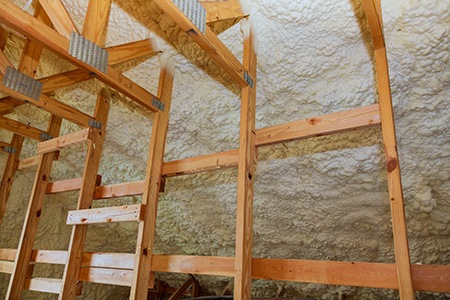
Let's get into how to paint over polyurethane. Before starting to paint, it is important to properly prepare the polyurethane surface for a flawless and durable finish by cleaning, sanding, and applying the right type of primer.
Cleaning the Polyurethane
The first step in preparing your polyurethane surface is cleaning it thoroughly. Using a soft cloth or sponge, gently scrub the surface with mild detergent and warm water to remove any dirt, dust, or grease. Be sure not to use harsh chemicals or abrasive materials that could damage the existing finish.
Sanding the Polyurethane
Sanding is important when painting over polyurethane because it helps create a rougher surface for better paint adhesion. Start using 220-grit sandpaper and lightly sand down all areas of your project piece until you have achieved an even texture across its entire surface. You can do this manually or using a powered type of sander.
Applying Primer to the Polyurethane
To further improve paint adhesion and prevent potential peeling or chipping, it's essential to apply a primer before painting over polyurethane. Choose an oil-based primer specifically designed for use on surfaces with existing finishes like polyurethane.
Using a brush or roller, spread an even layer of primer over the whole area and let it dry per the maker's directions. Once dried, lightly sand any rough spots using 220-grit sandpaper before applying paint.
Choosing the Right Paint for Painting Over Polyurethane
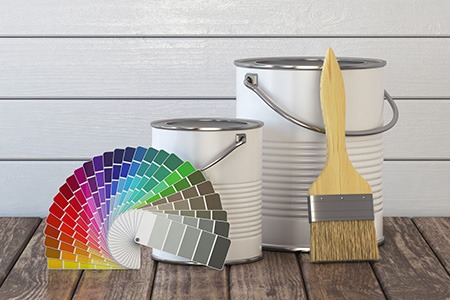
Selecting the right type of paint is crucial for achieving a long-lasting and professional-looking finish when painting over a polyurethane surface.
Oil-Based Paints
Due to their durability and high-quality finish, oil-based paints have been a preferred choice for many years. They adhere well to polyurethane-coated surfaces, providing excellent coverage with fewer coats compared to other paint types.
However, they also come with some drawbacks, such as longer drying times, strong odors during the application, and potential environmental concerns due to volatile organic compounds (VOCs).
Latex Paints
Latex paints, also known as water-based paints, are popular choices because they dry quickly and emit less odor than oil-based options while still offering good adhesion properties when applied over a primer on a polyurethane finish.
These environmentally friendly alternatives typically clean up easily with soap and water but may not provide the same level of durability as their oil-based counterparts in high-traffic areas or humid environments.
Acrylic Paints
Acrylic paints are a suitable choice for both interior and exterior projects, providing good adhesion, durability, and moisture resistance when used with a primer on polyurethane surfaces. They offer excellent adhesion, durability, and resistance to moisture when applied over a primer on a polyurethane-coated surface.
Painting Over Polyurethane: Tips & Techniques
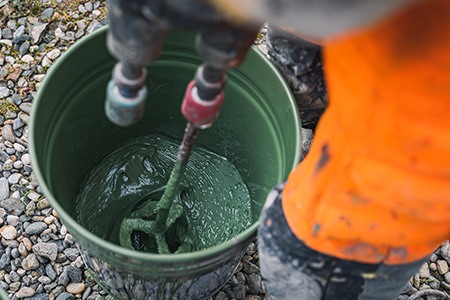
Can you paint over polyurethane? Yes, but you need to take the proper steps in the right order. If you're looking to update the look of your polyurethane-coated surface, painting over it is a great option. However, it's important to follow the right steps to ensure a long-lasting finish.
Preparing the Polyurethane Surface
Before you start painting, you need to prepare the polyurethane surface. This involves cleaning it thoroughly and sanding it to create a surface that the paint can adhere to. Here are the steps to follow:
- Clean the surface: Use a clean cloth and liquid sandpaper to wipe down the entire surface. This will remove any dirt, grime, or wax that may be present.
- Sand the surface: Use fine-grade sandpaper to lightly sand the surface. This will create a rough surface that the paint can adhere to. Use contour sanding grips for sanding curved or hard-to-reach areas. After sanding, wipe the surface with a dry cloth to remove any dust.
- Fill any gaps: If there are any gaps or holes in the surface, use wood filler to fill them in. Allow the filler to dry completely before sanding it down to create a smooth surface.
Choosing the Right Paint
Choosing the right paint is crucial for a successful painting project. Here are some things to consider when selecting paint for a polyurethane surface:
- Type of paint: Water-based paint or latex paint is the best option for painting over polyurethane. Oil-based paints can also be used, but they require a primer coat and a longer drying time.
- Finish: Choose a matte finish for a more subtle look or an enamel paint for a glossy finish.
- Color: Choose a color that complements the rest of the room or furniture piece.
Applying Paint to the Polyurethane Surface
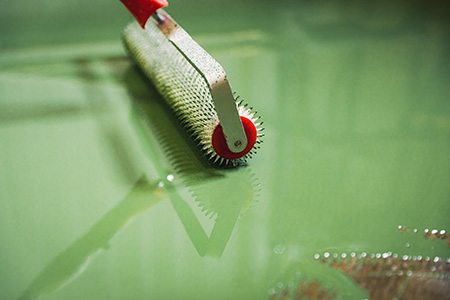
Once the polyurethane surface has been prepped and the paint selected, it's time to apply it for a flawless finish.
Mixing & Preparing the Paint
Before you start painting over polyurethane, make sure your paint is properly mixed by stirring it thoroughly using a paint stirrer. This ensures that all pigments are evenly distributed throughout the can of paint. If you're using an oil-based paint, remember to add some thinner according to manufacturer instructions for it to adhere better onto the primed surface.
Applying Even Coats of Paint with a Brush or Roller
Selecting appropriate tools: Choose high-quality brushes or rollers designed specifically for your type of paint (oil-based or latex). A good quality brush will help prevent streaks while providing smoother coverage.
Loading up your tool: Dip about half of your brush bristles into the can of paint, then tap off any excess against the side before starting the application; similarly, load up roller covers without saturating them completely so they don't drip when applied onto surfaces.
Painting technique: Apply thin coats rather than thick ones since multiple layers provide better durability than single heavy applications, which may result in peeling later on due to a lack of proper adhesion between the primer layer underneath the topcoat itself.
Maintaining a wet edge: Always work in small sections, moving from one area to another while maintaining a "wet edge" by overlapping your strokes slightly. This helps prevent lap marks and ensures an even finish.
Maintaining Your Newly Painted Polyurethane Surface
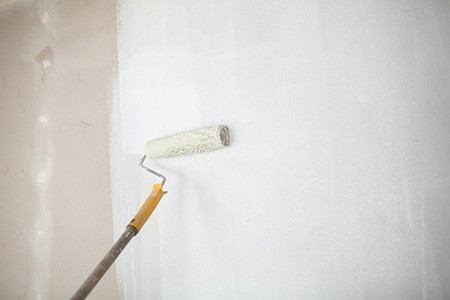
To ensure your polyurethane surface remains aesthetically pleasing and durable, it is essential to maintain its condition with regular maintenance.
Regular Cleaning & Dusting
To prevent dirt buildup on your freshly painted polyurethane surfaces, clean them regularly with a soft cloth or duster.
Gently wipe away any dust or debris that may accumulate over time without applying too much pressure on the paintwork. Use a mild soap solution mixed with water for more stubborn stains or marks. Avoid using abrasive cleaners or scrubbing pads that could damage the paint finish.
Touch-Ups as Needed
No matter how carefully you maintain your newly painted surfaces, accidents can happen, leading to scratches or chips in the paintwork. When these occur, it's crucial to promptly touch up those areas before they become more noticeable or damage the underlying material further.
Keep some leftover paint from your original project stored safely for such occasions so that you can easily match colors when performing touch-ups.
- Before starting any touch-up work, ensure the area is clean and dirt-free.
- Gently sand down any rough edges around damaged spots using fine-grade sandpaper.
- Apply a thin pigment coating utilizing a small brush, feathering the edges to mix with the encompassing area.
- Allow the touch-up paint to dry thoroughly before assessing if additional coats are needed for full coverage.
Painting Over Polyurethane Without Surprises
So, can polyurethane be painted over? Yes! Proper preparation and selection of materials are essential to ensure a successful paint job on polyurethane. To start, clean and sand the surface, then apply primer.
Choosing the right paint type is crucial when painting over polyurethane, and using even coats of paint with quality tools will help you achieve a smooth finish on your polyurethane surface. In addition, regular maintenance, such as dusting and touch-ups, will help keep your newly painted surface looking fresh for years to come.



